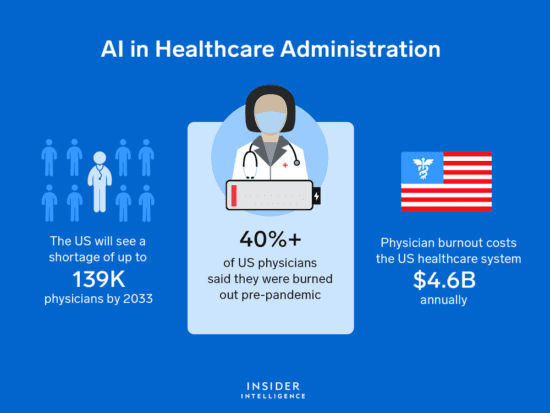It’s estimated that about 25% of this $4 trillion is due to administration, which means that we spend $1 trillion a year on paperwork. It’s no wonder that healthcare is now the number one employer, passing retail as of 2017 with 17 million jobs. A typical medical clinic or health system has to deal with so many different payers that many of its employees are occupied with filling out forms and making calls to ensure that they’re meeting each payer’s requirements, because that’s what pays the bills and keeps the lights on. When we think of care delivery institutions, this isn’t what typically comes to mind. Unfortunately, it’s a reality because of the disjointed payment system in our country and the lack of regulation to solve the problem.
The good news is that we can expect to see future workflow improvements through robotic process automation (RPA), artificial intelligence (AI), and other promising technologies. These technologies are a natural fit to improve efficiency through automating repetitive tasks with minor or moderate complexity. Most of these administrative functions are done electronically, making AI the perfect tool to “figure out” what to do and to perform activities like completing forms, sending information, and scheduling follow-ups.
LLMs from Google (Bard) and OpenAI (ChatGPT) have already made impressive progress when it comes to interpreting medical documentation. Healthcare-based NLP tools have also been released on open-source licenses by the National Library of Medicine (part of the National Institutes of Health), Amazon Comprehend Medical, and Google via its Healthcare Natural Language API. Healthcare AI tools for administrative automation will mostly depend on EHR data. There are tools like NYM that tap into EHR notes to translate health services into billable codes, while RPA platforms are using AI to extract data from EHRs to populate insurance claims forms. This is also known as “charge capture,” the process by which doctors translate patient visits and diagnoses into medical codes that can be billed to an insurer. Historically, this has been done by hiring people who read the doctor’s notes and update the coding for that visit.
Insurance companies use prior authorization to control costs by preventing unnecessary procedures. This is always a point of contention since doctors think they should be the ones to make decisions about what’s appropriate for their patients. However, insurance companies argue that testing and procedures are often ordered by doctors when medical guidelines don’t support them. Most recently, doctors have used ChatGPT to generate these letters to the insurance companies. Although a great time-saver, ChatGPT has shown an ability to provide false scientific references in these letters or fabricate patient data. This underlines the fact that although we’re heading for exciting days, the road to get there is not fully paved yet. However, one of the early use cases for generative AI is that of generating prior authorization letters that summarize key information from the EHR and explain why procedures are necessary.
Patient-facing chatbots trained on medical literature with LLMs and patient data can build a holistic view of a patient’s condition using multiple modalities, ranging from unstructured descriptions of symptoms to continuous glucose monitor readings and patient-provided medication logs. After interpreting this heterogeneous data, the models could interact with the patient, providing detailed advice and explanations. Importantly, these models can facilitate accessible communication, providing clear, readable, or audible information on the patient’s schedule.
AI-based chatbots perform a number of functions that could improve operations at medical practices. These solutions can centralize resources, offering location-based information on the programs that are available and providing dynamic answers to specific questions about insurance. An obvious advantage of these chatbots is that they’re available 24/7. We just need to make sure that they can integrate with the scheduling tools and EHRs that are currently in use.
Of course, until these patient-facing models have been fully tested and deemed to be safe and effective, it is unlikely that they will be used to advise patients about their medical conditions and management without human supervision. However, we are marching toward the day where fully tested models trained on the best medical literature and complete medical data can autonomously help patients. When will that be? Hard to say but my guess would be in a couple of decades! It might seem like a long time but it will take that long to create unified patient records, address safety and privacy concerns, build models trained on comprehensive medical literature, and do long-term prospective clinical trials to document their efficacy and safety.






